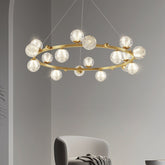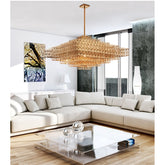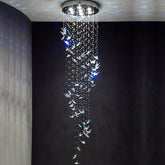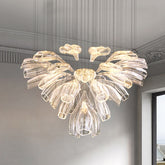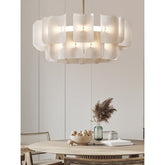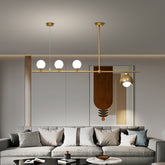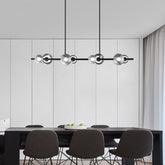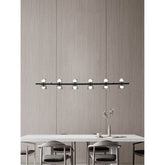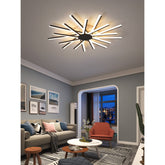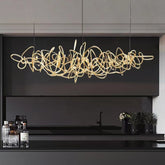Influence of Cultural Designs on Modern Lighting: Global Inspirations for Your Home
Modern 2024 lighting design draws from various cultural influences, merging traditional styles with contemporary trends to create unique and captivating environments. As globalization blurs geographical boundaries, modern lighting has become a tapestry of cultural designs. From the intricate lanterns of Morocco to the minimalist lines of Scandinavian fixtures, these diverse influences bring a world of creativity into our homes. This article explores how cultural designs from around the world inspire modern lighting, offering global inspirations for your home.
The Role of Cultural Designs in Lighting
Cultural Significance of Lighting
Lighting has always held cultural significance, symbolizing various aspects of life, from religious rituals to social gatherings. In many cultures, light is a metaphor for knowledge, divinity, and life itself. For instance, in Hinduism, the festival of Diwali is celebrated with oil lamps and candles to signify the victory of light over darkness. Similarly, Chinese lanterns symbolize prosperity and good fortune during festivals.
Evolution of Lighting Designs
The evolution of lighting design mirrors the technological and cultural advancements of societies too. Traditional designs often utilized available materials and catered to the needs and aesthetics of the time. As societies evolved, so did their lighting solutions, incorporating new materials, technologies, and design philosophies. Today, modern lighting designers draw inspiration from these rich cultural heritages, blending traditional elements with contemporary innovations.
Global Inspirations in Modern Lighting
Moroccan Lighting & Patterns
Moroccan lighting is renowned for its unique designs and warm, inviting glow. Traditional Moroccan lanterns, often made from metal and colored glass, cast elaborate patterns of light and shadow, creating a magical ambiance. These lanterns are inspired by the country's rich history and diverse cultural influences, including Berber, Arab, and Andalusian elements.
Incorporating Moroccan Lighting at Home:
- Use Moroccan lanterns as statement pieces in living rooms or entryways.
- Choose Moroccan lanterns with colorful glass to add a vibrant touch to your decor.
- Place Moroccan lanterns at different heights to create a dynamic lighting effect.
Scandinavian Lighting & Minimalism
Scandinavian design is synonymous with minimalism, functionality, and a connection to nature. This design philosophy extends to lighting, where simple yet elegant fixtures are favored. Scandinavian lighting often features clean lines, natural materials like wood and metal, and a focus on creating a cozy, inviting atmosphere, known as "hygge."
Incorporating Scandinavian Lighting at Home:
- Opt for pendant lights with clean, geometric shapes.
- Use natural materials such as wood or metal in your light fixtures.
- Choose soft, warm lighting to create a cozy ambiance.
Japanese Lighting & Use of Space
Japanese lighting design emphasizes harmony, simplicity, and a deep respect for nature. Traditional Japanese lanterns, known as "chochin," are made from washi paper and bamboo, offering a soft, diffused light that creates a serene and tranquil atmosphere. This design philosophy is rooted in the Japanese aesthetic principles of "wabi-sabi" (beauty in imperfection) and "ma" (space).
Incorporating Japanese Lighting at Home:
- Use paper lanterns to create a soft, diffused light.
- Incorporate natural materials such as bamboo or wood in your lighting fixtures.
- Embrace minimalism and simplicity in your overall lighting design.
Indian Lighting & Festivity
Indian lighting designs are vibrant, colorful, and often ornate, reflecting the country's rich and incredibly diverse cultural heritage and festive spirit. Traditional oil lamps (diyas) and intricate metal lanterns are commonly used during festivals and celebrations throughout the year. These lighting designs are not just functional but also serve as decorative elements that add a touch of grandeur to any space.
Incorporating Indian Lighting at Home:
- Use ornate metal lanterns as decorative pieces in your living space.
- Opt for colorful glass lamps to add a festive touch to your decor.
- Incorporate traditional oil lamps for a touch of authenticity during festivals.
Middle Eastern Lighting & Opulence
Middle Eastern lighting is characterized by its opulence, intricate patterns, and luxurious materials. Traditional lanterns, often made from brass or copper, are adorned with elaborate designs that reflect the region's rich artistic heritage. These lighting fixtures create a warm, inviting glow that adds a touch of exotic elegance to any space.
Incorporating Middle Eastern Lighting at Home:
- Choose brass or copper lanterns with intricate middle eastern patterns.
- Use lanterns with colored glass to create a warm, inviting ambiance.
- Place lanterns in strategic locations to cast beautiful shadows and patterns on sand.
African Lighting & Organic Materials
African lighting designs are inspired by the continent's diverse nature, landscapes, cultures and natural beauty. Traditional African lamps often use organic materials such as clay, wood, and reeds, reflecting a deep connection to environment. These designs are characterized by bold, geometric patterns and earthy tones that add a unique, rustic charm to any interior that makes them easy to notice anywhere.
Incorporating African Lighting at Home:
- Choose lamps made from natural materials like clay or wood.
- Incorporate unique African patterns in your lighting fixtures.
- Use earthy tones to create a warm, rustic ambiance.
Contemporary Interpretations of Traditional Designs
Fusion of Styles
Modern lighting designers often blend these above mentioned elements from various cultural designs to create unique, contemporary fixtures. This fusion of styles results in lighting that is both aesthetically pleasing and culturally rich. For example, a modern chandelier might combine Moroccan patterns with Scandinavian minimalism, offering a piece that is both intricate and understated, getting the best out of both worlds.
Examples of Fusion Lighting:
- A pendant light that combines Japanese paper lantern design with Scandinavian simplicity. The fusion piece, "Serene Nordic Glow," exemplifies how two distinct cultural designs can harmonize into a single, captivating fixture.
- A floor lamp that merges African geometric patterns with Middle Eastern opulence. The "Sahara Majesty" floor lamp seamlessly combines the bold geometric patterns characteristic of African design with the intricate and opulent details of Middle Eastern artistry.
- A table lamp that incorporates Indian vibrancy with Moroccan intricacy. The "Raj Mahal Glow" table lamp beautifully combines the vibrant colors and patterns of Indian design with the intricate craftsmanship of Moroccan artistry.
Technological Innovations
Advancements in technology have enabled designers to reinterpret traditional designs in innovative ways. LED lighting, smart lighting systems, and energy-efficient materials allow for the creation of fixtures that maintain the essence of cultural designs while offering modern functionality.
Examples of Technological Innovations in Lighting:
- Traditional Japanese Shoji lamps, which use paper shades to create soft, diffused light, have been upgraded with Wi-Fi-enabled LED bulbs. These lamps now support various smart home systems, allowing users to control them through apps or voice commands.
- Inspired by the traditional Indian art of Rangoli, Indian LED floor lamps feature intricate, colorful designs and are embedded with motion sensors. The LEDs are arranged in patterns that mimic the vibrant Rangoli designs typically created during festivals.
- Scandinavian lighting designs, known for their minimalism and functionality, have incorporated adaptive brightness technology. These lights adjust their intensity based on the time of day and the natural light available, promoting energy efficiency and enhancing light quality.
Practical Tips for Incorporating Cultural Lighting Designs
Understanding Your Space
Before incorporating cultural lighting designs, it's essential to understand your space and its lighting needs. Consider the size of the room, the existing decor, and the desired ambiance. This understanding will help you choose the right cultural elements and fixtures that complement your space.
Tips for Assessing Your Space:
- Measure the dimensions of the room to determine the appropriate size of lighting fixtures.
- Evaluate the existing decor to ensure the new lighting design complements the overall style.
- Consider the function of the room and the type of lighting required (e.g., ambient, task, accent).
Mixing and Matching Styles
Don't be afraid to mix and match different cultural designs to create a unique and personalized lighting scheme. The key is to find a balance between different styles, ensuring they complement rather than clash with each other.
Tips for Mixing and Matching Styles:
- Choose a dominant style and use elements from other cultures as accents.
- Ensure a cohesive color palette to tie different styles together.
- Experiment with different textures and materials to add depth and interest. Study the reason behind every decision that led to the cultural style.
DIY Cultural Lighting Projects
For those who enjoy hands-on projects, creating your own cultural-inspired lighting fixtures can be a rewarding experience. DIY projects allow you to customize designs to suit your taste and space, adding a personal touch to your decor.
Ideas for DIY Cultural Lighting Projects:
- Create Moroccan-inspired lanterns using metal frames and colored glass.
- Make Japanese paper lanterns using washi paper and bamboo frames.
- Design Indian-style oil lamps using clay and Indian painting techniques.
Final Thoughts
It is clear that the influence of cultural designs on modern lighting is a testament to the richness and diversity of global heritage. By drawing inspiration from various cultures, contemporary lighting designers create fixtures that are not only functional but also deeply meaningful and aesthetically pleasing.
Whether you prefer the intricate patterns of Moroccan lanterns, the minimalist elegance of Scandinavian lights, or the vibrant colors of Indian lamps, there is a world of cultural inspiration to explore. By incorporating these diverse designs into your home, you can create a unique and inviting atmosphere that reflects your personal style and appreciation for global artistry.












































































































